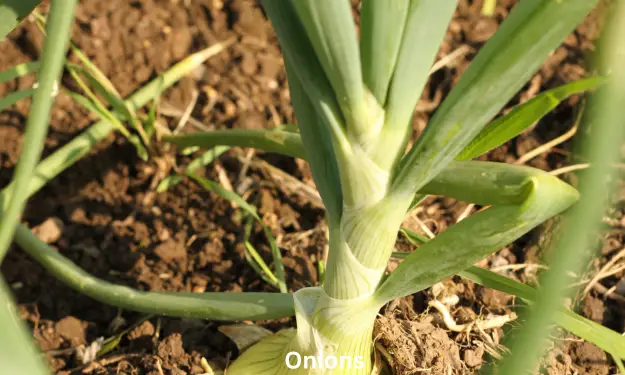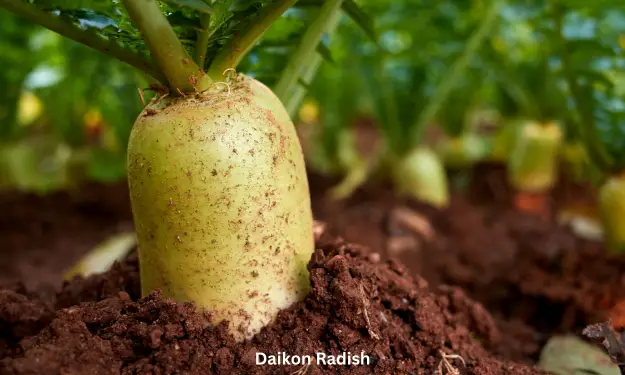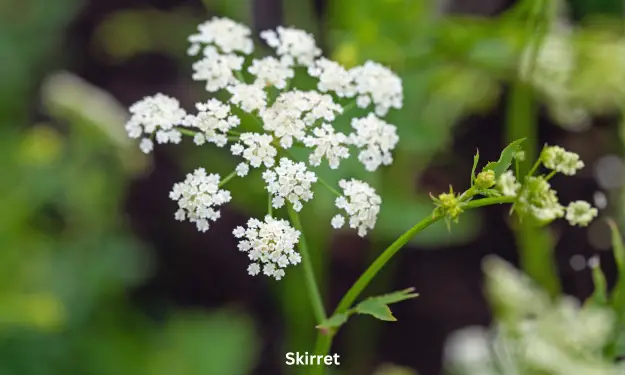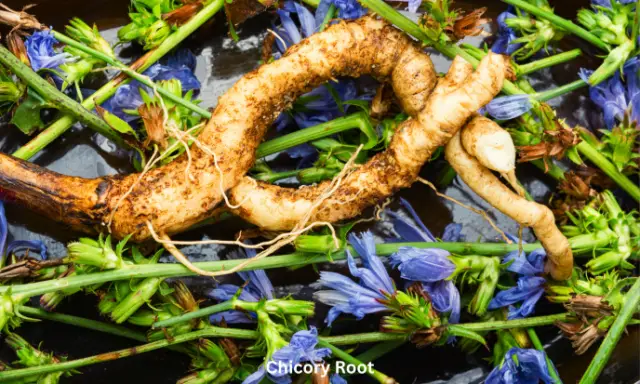When it comes to the colorful tapestry of vegetables, we usually picture the verdant fields and the vibrant display at the neighborhood market.
But, beneath the surface, there is a fascinating world that is often overlooked: the world of underground vegetables.
These underground treasures not only add distinctive flavors and textures to our culinary repertoire but also have a high nutritional value.
Let us explore this fascinating world and discover the secrets it holds.

25 Vegetables That Grow Underground
List of Vegetables That Grow Underground

1). Potatoes
At the forefront of underground vegetables are the humble potatoes. Known for their versatility, potatoes come in various varieties, each with its own distinct taste and texture. From creamy Yukon Golds to starchy Russets, these tubers are a staple in cuisines across the globe. Whether mashed, roasted, or fried, potatoes are a reliable source of essential nutrients like vitamin C, potassium, and dietary fiber.
2). Carrots

Carrots, with their vibrant orange hue, are not only visually appealing but also incredibly nutritious. Packed with beta-carotene, an antioxidant that converts to vitamin A in the body, carrots promote good vision and overall eye health. Their natural sweetness makes them a favorite for snacks, salads, and soups, adding both flavor and nutrition to our meals.
3). Beets

Beets, with their earthy flavor and deep red color, are true gems hidden beneath the soil. Rich in antioxidants and nitrates, beets offer various health benefits, including improved blood flow and reduced blood pressure. Roasted, pickled, or grated raw into salads, beets add a touch of elegance and nutrition to our plates.
4). Radishes

Radishes bring a peppery crunch to the world of underground vegetables. These colorful root vegetables come in various shapes and sizes, from the small, round cherry belle to the elongated daikon. Radishes are not only low in calories but also rich in vitamin C, making them a refreshing addition to salads and a zesty snack on their own.
5). Onions

Onions, a cornerstone of many savory dishes, grow underground as bulbs packed with layers of flavor. Whether they’re the pungent red onions, milder yellow onions, or sweet Vidalias, these alliums add depth and complexity to countless recipes. Beyond their culinary prowess, onions contain compounds with potential health benefits, including anti-inflammatory and antioxidant properties.
6). Sweet Potatoes

Sweet potatoes, often confused with their distant cousin, the regular potato, are a nutritional powerhouse. These orange-fleshed wonders are rich in vitamins A and C, fiber, and antioxidants. Their natural sweetness makes them a delightful addition to both savory and sweet dishes, from baked fries to pies.
7). Garlic

How To Treat Garlic Before Planting
Garlic, with its pungent aroma and distinctive flavor, grows underground in clusters of cloves. Beyond its culinary uses, garlic has been revered for its potential health benefits. Allicin, a compound found in garlic, is known for its antimicrobial properties and potential to boost the immune system. Whether roasted, minced, or sautéed, garlic adds depth and complexity to a wide range of dishes.
8). Turnips

Turnips, with their white and purple hues, are root vegetables that offer a unique combination of earthiness and mild spiciness. High in fiber, vitamins, and minerals, turnips make a nutritious addition to stews, soups, and roasts. The greens, often overlooked, are also edible and rich in nutrients.
9). Ginger

Widely celebrated for its aromatic and spicy flavor, ginger is an underground rhizome that adds zing to both savory and sweet dishes. Beyond its culinary uses, ginger has been traditionally used for its potential anti-inflammatory and digestive benefits. Whether used in teas, stir-fries, or desserts, ginger brings warmth and depth to a variety of recipes.
10). Jerusalem Artichokes

Jerusalem artichokes, also known as sunchokes, are a unique and often underappreciated member of the underground vegetable family. With a nutty, sweet flavor, these knobby tubers can be enjoyed roasted, sautéed, or even raw in salads. They contain inulin, a type of fiber that may contribute to digestive health.
11). Parsnips

Parsnips are the unsung heroes of the root vegetable world, boasting a sweet and nutty flavor. These ivory-colored roots are rich in vitamins and minerals, particularly potassium and vitamin C. Roasting or mashing parsnips enhances their natural sweetness, making them a delightful addition to winter dishes and purees.
12). Turmeric

Turmeric, renowned for its vibrant golden hue, is a rhizome that grows underground. Beyond its culinary uses, turmeric contains curcumin, a compound with potent anti-inflammatory and antioxidant properties. Widely used in curries, soups, and teas, turmeric not only adds a warm and earthy flavor but also brings potential health benefits.
13). Rutabagas

Rutabagas, often confused with turnips, are root vegetables with a distinct flavor that balances sweetness and peppery notes. High in fiber, vitamin C, and potassium, rutabagas are versatile in the kitchen. Mash them, roast them, or include them in hearty stews—these golden-fleshed vegetables add a comforting touch to cold-weather meals.
14). Yams

Yams, with their starchy and slightly sweet flesh, are tubers that grow underground. Rich in complex carbohydrates, fiber, and vitamins, yams are a staple in many cuisines. Baked, fried, or mashed, yams offer a nutritious and delicious alternative to traditional potatoes.
15). Celeriac

Celeriac, also known as celery root, is a gnarled and knobby underground vegetable that surprises with its mild celery flavor. Despite its rough exterior, celeriac can be transformed into creamy soups, flavorful purees, or crispy fries. It is a low-calorie option packed with essential nutrients, including vitamin K and phosphorus.
16). Taro

Taro, a staple in tropical regions, is a starchy root vegetable with a nutty flavor. Rich in dietary fiber, vitamins, and minerals, taro is used in various culinary applications, from savory dishes to desserts. Boiled, mashed, or fried, taro adds a unique and satisfying element to diverse cuisines around the world.
17). Daikon Radish

Daikon radish, a large and mild-flavored root vegetable, is a staple in Japanese cuisine. With its crisp texture and subtle peppery taste, daikon is often used in salads, pickles, and as a crunchy topping for various dishes. This versatile radish also offers digestive benefits and is a low-calorie addition to a healthy diet.
18). Salsify

Salsify, also known as the oyster plant due to its faint oyster-like flavor, is a lesser-known underground vegetable. This root vegetable has a mild taste and a creamy texture when cooked. Often used in soups, stews, or simply roasted, salsify adds a unique touch to dishes while providing dietary fiber and essential nutrients.
19). Kohlrabi

Kohlrabi, with its bulbous stem and alien-like appearance, is a member of the cabbage family. Both the bulb and leaves are edible, offering a mild, sweet taste reminiscent of broccoli stems. Kohlrabi can be enjoyed raw in salads, roasted, or incorporated into soups, providing a good source of vitamin C and potassium.
20). Skirret

Skirret, an ancient root vegetable, is making a comeback in culinary circles. With a taste reminiscent of parsnips and carrots, skirret is appreciated for its versatility. It can be boiled, roasted, or used in casseroles. As an excellent source of dietary fiber and minerals, skirret adds both flavor and nutrition to your plate.
21). Sunroot (Sunchoke)

Sunroot, also known as sunchoke, is a knobby, tuberous root with a sweet, nutty flavor and a hint of artichoke undertones. These versatile tubers can be enjoyed raw in salads, roasted, or blended into creamy soups. Sunroots are not only delicious but also provide dietary fiber, potassium, and iron.
22). Chinese Water Chestnut

Chinese water chestnuts are aquatic vegetables that grow underground near the water’s edge. With a crisp, juicy texture and a mildly sweet taste, these tubers add a delightful crunch to stir-fries, salads, and Asian-inspired dishes. They are low in calories and a good source of B-complex vitamins.
23). Jicama

Jicama, often referred to as the Mexican turnip or yam bean, is a crisp and refreshing root vegetable. With a mildly sweet flavor and water chestnut-like crunch, jicama is perfect for fresh salads, slaws, or as a crunchy snack. It’s rich in dietary fiber, vitamin C, and various minerals.
24). Chicory Root

Chicory root, although commonly used as a coffee substitute, is also a versatile culinary ingredient. When roasted, it develops a deep, earthy flavor. Ground chicory can be used in baking, and the leaves can be cooked or added raw to salads. Additionally, chicory root contains inulin, a prebiotic fiber that may benefit gut health.
25). Lotus Root

Lotus root, an aquatic vegetable, grows underwater and is prized for its unique appearance and crisp texture. Sliced lotus root is a popular ingredient in Asian cuisine, used in stir-fries, soups, and pickles. This root vegetable is rich in vitamins, minerals, and dietary fiber.
Here Are Frequently Asked Questions (FAQ) About Vegetables That Grow Underground:
Q1: What are underground vegetables?
A1: Underground vegetables are plants that produce edible parts beneath the soil. Common examples include potatoes, carrots, beets, radishes, and onions.
Q2: What nutrients do underground vegetables provide?
A2: Underground vegetables are rich in essential nutrients such as vitamins (e.g., vitamin C, vitamin A), minerals (e.g., potassium, iron), dietary fiber, and antioxidants. The specific nutritional content varies among different types of underground vegetables.
Q3: Are underground vegetables healthy?
A3: Yes, many underground vegetables are highly nutritious. They contribute to a well-balanced diet by providing essential vitamins, minerals, and dietary fiber. Additionally, they often contain compounds with potential health benefits, such as antioxidants.
Q4: How can I incorporate underground vegetables into my diet?
A4: Underground vegetables can be enjoyed in various ways. They can be roasted, boiled, mashed, sautéed, or consumed raw in salads. Including a variety of these vegetables in your meals adds both flavor and nutritional diversity.
Q5: Are there any lesser-known underground vegetables?
A5: Yes, there are several lesser-known underground vegetables, such as salsify, skirret, lotus root, and sunroot (sunchoke). These vegetables offer unique flavors and textures, contributing to culinary creativity.
Q6: Can I eat the leaves of underground vegetables?
A6: In some cases, yes. For example, the greens of beets and turnips are edible and nutritious. However, not all underground vegetable greens are edible, so it’s important to research each specific vegetable.
Q7: What is the difference between yams and sweet potatoes?
A7: While yams and sweet potatoes are often confused, they are botanically distinct. True yams are starchy tubers with rough, scaly skin, and sweet potatoes have smoother skin and come in various colors, including orange, purple, and white.
Q8: Are there health benefits associated with consuming underground vegetables?
A8: Yes, many underground vegetables offer health benefits. For example, they may support heart health, boost the immune system, and provide antioxidants that help protect cells from damage.
Q9: How should underground vegetables be stored?
A9: Most underground vegetables should be stored in a cool, dark place. Potatoes, for instance, should be kept in a cool, dry place, while carrots and beets can be refrigerated in a plastic bag.
Q10: Can I grow underground vegetables at home?
A10: Yes, many underground vegetables can be grown at home, either in a garden or in containers. Potatoes, carrots, radishes, and herbs like garlic and ginger are commonly grown by home gardeners.




